SENKAKU-DIAOYU ISLANDS
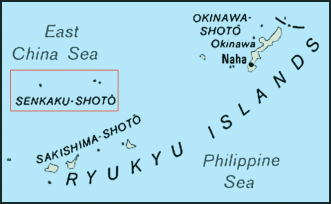
Senkaku-Diaoyu Islands map Both China and Japan claim the fish-rich and potentially-oil- and natural-gas-rich islands — known to the Japanese as the Senkaku Islands, to the Chinese as the Diaoyu Islands and to the Taiwanese as the Tiaoyutai Islands — between Okinawa and Taiwan in the East China Sea. The Senkaku Islands are in Ishigaki, Okinawa Prefecture. Covering only seven square kilometers of uninhabited, rocky land. they comprise five islets--Uotsurijima, Kita-kojima, Minami-kojima, Kubashima and Taishoto--and three rocks. The islands are now uninhabited but in the 1940s there was a bonito processing factory on Uotsurijima, the largest of the Senkakus. China and Japan both see the islands lying between them as symbols of national pride.
On January 14, 1895: The Japanese government formally obtained control of the Senkaku-Diaoyu Islands. Japan asserts the islands were not owned by anyone prior to their occupation while China maintains it has sovereignty over the island chain for centuries. On September 2, 1945: Senkaku-Diaoyu Islands, as part of Ryukyu Islands, came under the US government's control after the surrender of Japan at the end of the second world war.
On June 17, 1971: The Agreement between Japan and the United States of America Concerning the Ryukyu Islands and the Daito Islands was signed between Japan and the US, returning the Senkaku Islands (as part of the Ryukyu Islands) to Japanese administration. This triggered the first anti-Japanese protests, led by Taiwan. On: August 12, 1978: The Japan-China Peace and Friendship Treaty was signed between China and Japan, in which the dispute over the isles is put aside for future resolution.
On July 14, 1996: Right-wing Japanese Youth Association members landed and built a lighthouse on one of the islets, prompting a series of protests from mainland China, Hong Kong and Taiwan. On September 26, 1996: Hong Kong activist David Chan drowned after jumping into waters off the Diaoyu Islands during a pro-China protest. On September 29, 1996: Tens of thousands of people gathered for a candlelight vigil in Victoria Park to mourn David Chan’s death and protest against Japan’s claim of the islands. On October 7, 1996: Three activists from Hong Kong and Taiwan landed on the Diaoyu Islands. On March 24, 2004: Activist Feng Jinhua and six others from China land on the Diaoyu Islands, the first time mainland activists successfully landed on the islands.
There are other islands that are disputed. The Okino Tori Shima islands, 1,118 miles south of Tokyo, consists of two rocks which barely pierce the water during high tide. Although the islands themselves are worthless, owning them gives Japan exclusive fishing and mining rights to more than 154,452 square miles of ocean that surround around them. Rich cobalt and manganese deposits may lie in the seabed offshore and the waters are teaming with fish and squid that help feed Japan's voracious appetite for seafood.
The Law of the Sea states the islands must be above sea level. To maintain their claim on the islands, which are only 27 inches above sea, the Japanese government spent several million dollars to build a wave absorbing barrier to keep the islands from being eroded by the sea.
The South China Sea in which the islands lie is important to Japan. About 70 percent of Japan’s imported oil passes through the South China Sea. China claims most the South China Sea.
Japan’s Claim to the Senkaku-Diaoyus
The Japanese claim on the Senkaku islands dates back 1895 when the islands were declared by the government as part of Okinawa prefecture. After the signing of San Francisco Peace Treaty in 1951, Japan formally lost all of the territories it acquired after 1895. There was little interest in the islands until a geological surveys released in 1968 and 1972 reported their might be oil and minerals around the islands. Also at stake are the fishing rights. Financial Times among others has pointed out Beijing “did no challenge Japan’s sovereignty claim” until learning that the sea floor near the Senkakus could hold oil deposits.
During the U.S. occupation of Okinawa, the Senkaku-Diaoyu Islands were used for military drills by U.S. forces. When the U.S. returned Okinawa to Japan in 1972, the Japanese also claimed the Senkaku-Diaoyu Islands. When Japan and China signed a joint communique in 1972, the issues of the islands was not raised.
When China and Japan signed a peace treaty in 1978, vice-premier Deng Xiaoping said the dispute over the islands "will be shelved until the next generation comes up with a solution." Also in 1978, the ultra-rightist group Nihon Seinen Sha (Japan Youth Federation) set up a makeshift lighthouse on the largest of the islands. After of period of time the same group returned to the island to rebuild the lighthouse and seek official recognition.
China’s Claim to the Senkaku-Diaoyu Islands
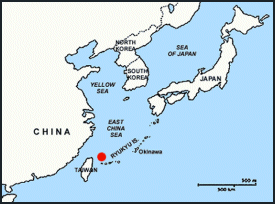
Senkaku-Diaoyu Islands map In 1971, Taiwan and China both officially claimed the Senkaku-Diaoyu Islands as theirs. Yutaka Ito and Toru Makinoda wrote in the Yomiuri Shimbun: China holds that Japan stole the Senkaku-Diaoyu Islands at the end of the Sino-Japanese War. China focuses on the 1943 Cairo Declaration that stipulated territory acquired by Japan from the Qing dynasty should be returned to the Republic of China. As Japan accepted the 1945 Potsdam Declaration, which called for implementation of the Cairo Declaration, China should have a valid claim to territorial sovereignty over the islands.[Source: Yutaka Ito and Toru Makinoda, Yomiuri Shimbun, October 13, 2012]
Concerning China's claims, based on the Cairo Declaration, the government holds that the Senkaku-Diaoyu Islands were not included in the territory mentioned in the declaration, and that China also recognized the islands were part of Japan's territory after the Potsdam Declaration was announced.
Foreign Minister Koichiro Gemba rebutted China's claims, noting that China first asserted its territorial sovereignty claim over the islands in the 1970s. Gemba also pointed out a Chinese map of the world published in 1960 clearly identified the Senkaku-Diaoyu Islands as "the Senkaku Group of Islands," as well as the name "Uotsurijima island." Also, the minister said there was a description of "the Senkaku Islands, Yaeyama District, Okinawa Prefecture, Empire of Japan" in a letter of appreciation sent to Japan from the then consul of the Republic of China in Nagasaki in 1920.
Senkaku-Diaoyu Island Dispute Heats Up
In 1996, ultra-nationalists erected on a lighthouse (actually a thin aluminum beacon about 15 feet high) on the main Senkaku-Diaoyu island. By this time four of the five islands were technically the private property of two Tokyo businessmen active in ultra-nationalist politics. Beijing was upset by Tokyo's tolerance of the actions by the ultra-rightists.
The people of China, Taiwan and Hong Kong were all unified in their disgust with Japan. In Hong Kong in 1996, protestors took to the streets and burned a Japanese flag. One Hong Kong teacher told Newsweek, "Our dream is that the Beijing navy would sail in from the left, the Taiwan navy would sail in from the right and we would take the Japanese together as a strong national force."
In September 1996, a freighter with 18 protestors from Hong Kong and Taiwan was turned back from the islands with the lighthouse by Japanese coast guard ships. Four protestors jumped into the water to symbolically claim the seas around the island for China. One of the protesters, 45-year-old David Chan, drowned in the choppy seas.
In March 2004, seven Chinese nationalists land on Senkaku-Diaoyu. They were arrested by Japanese police and coast guard personnel that arrived by helicopter. The seven were detained for a couple days and deported. The incident got quite a bit of press coverage in Japan and stirred up nationalist sentiments. In Beijing, a few dozen people held ani-Japanese demonstrations outside the Japanese embassy.
China has also been angered by textbooks that show disputed island in the East China Sea as belonging to Japan.
Natural Gas in Waters Between Japan and China
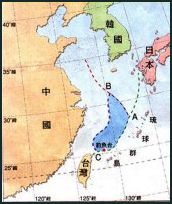
Senkaku-Diaoyu Islands map There are large undersea natural gas fields in waters claimed by both China and Japan in the East China Sea about halfway between Okinawa and the Chinese mainland. The Chunxiao and Tianwaitian natural gas fields lie in China’s exclusive economic zone. The Chunxiao field covers 8,500 square miles and holds up to 9 trillion cubic feet of gas, enough to meet China’s needs for seven years.
The area is near a group of disputed islands claimed by Japan and China known as the Senkaku to the Japanese, Diaoyu to the Chinese and Tiaoyutai to the Taiwanese. The actual line of demarcation of the boundary of the exclusive economic zones (EEZ) between China and Japan is a matter of dispute. Japan wants to make a deal but China seems more intent and trying to get away with as much as it can without actually violating international law. China so far has drilled only waters in its EEZ but it has angered Japan because these areas are so close to the disputed border.
According to the United Nations Convention on the Law of the Sea each coastal nation controls a an economic coastal zone that extends 200 nautical miles (230 miles, 375 kilometers) from the shoreline. The distance between Okinawa ad China is about 400 miles. Japan advocated a median line between the two countries. China advocates setting its economic border on the eastern extension of the continental shelf, a concept that pushed the border 50 miles of f the Okinawa archipelago. It seems unlike the two countries will ever agree on the line.
An area of 400 square kilometers, or 150 square miles, lies at the heart of the dispute. Japan has suggested that Japan and China tap the gas fields together. Thus far China has rejected these offers. Japan has also demanded that China make pubic its survey and drilling results because two of the three major gas fields that China found are believed to extend into territory claimed by Japan. Beijing has reportedly awarded exploration right to Chinese companies to explore blocks that extend into Japan’s EEZ.
Four main natural gas fields from north to south (Chinese name in parentheses): 1) Asunaro (Longjing); 2) Kusunoki (Duanqiao); 3) Kashi (Tianwaitian), closest to the Chinese mainland; 4) Shirakaba (Chunxiao)
Drilling for Natural Gas in Waters Between Japan and China
In June 2004, China began developing the Chunxiao site. It is now aggressively drilling at Chunxiao and Tianwaitian while Japan has yet go beyond doing geological surveys partly because the most promising areas for oil and gas are in disputed areas. China has gas production platforms less than a mile west of waters claimed by Japan. Japan claims that this platform is sucking gas from a deposit that extends over Japan’s side of the line.
In 2004, China began laying 291-mile gas pipeline between Shanghai to Chunxiao. Ironically $120 million for the $1 billion project came from Japanese ad.
Japan has earmarked $125 million to search for oil I the disputed area. In March 2005, the Japanese hired a Norwegian seismic ship to do surveys for oil and gas, While it was doing so it was treated as a spy ship by the Chinese and followed by Chinese ships. Japan is spending $100 million for its own seismic ship.
In 2005, the Japanese government awarded the Japanese company Teikoku Oil right to drill for oil at three sites near the “median line” that Japan says divide the Japan’s and China’s EEZ. In July 2005, China called Japan’s plan for drilling “a violation.”
In September 2005, Japan urged China to stop developing the disputed gas fields and called for joint exploration. In March 2006, China proposed that Japan and China jointly explore for oil and gas at one site the East China Sea together. Japan rejected the proposal. The site proposed by China is thought to be one that doesn’t contain much oil or gas. The disputed areas where gas has been found were not part of the proposal. Japan repeated its suggestion that the disputed areas should be jointly developed.
In October 2006, Chinese President Hu and Japanese Prime Minister Abe agreed to aim to resolve the dispute early with some of joint development. And promised to make the East China Sea a “sea of peace, cooperation and friendship.”
China began production at the Chunxiao field in the first half of 2006. An official with CNOOC said China intends to “launch normal production operations on its own territory.” According to a CNOOC year end report for 2006 listed on its website production at Tianwaitian field was 113,267 cubic meters of natural gas a day and 42 barrels of oil a day. Production is believed to be much higher than that. No production figures were given for the Chunxiao, Canxue and Duanqiao fields.
Natural Gas Deal Between Japan and China
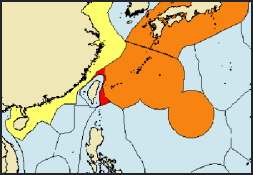
Senkaku-Diaoyu Islands map
areas claimed by Japan and China In 2008, China and Japan agreed to share the development of the Shirakaba and Asunaro gas fields. The agreement to develop the Shirakaba field was announced during a visit by Chinese President Hu Jintao to Japan.
Japan has offered to provide much of the funding for joint development of natural gas deposits in the East China Sea. China is reluctant to a agree to joint development because it feels that such an agreement would invalidate China’s claim on the entire continental shelf.
In June 2008, Japan and China reached an accord on developing the natural gas fields in the East China Sea, with Japan investing in a gas field already operated by China (the Chunxiao field) and the two nations jointly exploring an area not yet developed (the Asunaro gas field, which China calls the Longjing field). An agreement was not made on the Asunaro field, in part because of South Korean claims in the area.
After the agreement was made Japan discovered that China was developing a natural gas field known as Tiawaitan to the Chinese and Kashi to the Japanese and lodged a complaint saying development of the site went against the sprit of the agreement. China responded by saying that it had the right to drill at the site.
Comparing the Senkaku-Diaoyu and South China Sea Disputes
China's strategy of using fishing boats and fisheries patrol vessels to give the impression that the area belongs to China is similar to what China is doing in the South China Sea. Takashi Shiraishi wrote in the Yomiuri Shimbun: Probably because of such developments, not a few people in Japan and elsewhere have tried to address the Senkaku-Diaoyu issue by coupling it with the territorial disputes in the South China Sea. This is valid if we want to understand such questions as China's maritime strategy. But it is important to remember that the issues surrounding the Japanese islands in the East China Sea and the disputed South China Sea are different in nature as territorial issues. [Source: Takashi Shiraishi, Yomiuri Shimbun, September 24, 2012. Shiraishi is president of both the National Graduate Institute for Policy Studies and the Institute of Developing Economies, Japan External Trade Organization]
The Senkaku Islands have been under Japan's effective control. It is Japan's position that there is no territorial conflict on the Senkakus, whatever China says with respect to the sovereign status of the islands.Therefore, there was no need for Japan to provoke China by taking a theatrical posture for the purpose of declaring Japanese sovereignty over the Senkakus. It would have been good enough to maintain this country's effective control of the island group calmly.
The territorial disputes in the South China Sea are of different nature, because all the parties involved--Brunei, Malaysia, the Philippines and Vietnam, as well as China--acknowledge that they have disputes over islands, reefs and shoals there. This is why the Association of Southeast Asian Nations and China signed the "Declaration on the Conduct of Parties in the South China Sea" in 2002. But tensions have mounted over the issues in recent years.
Island Dispute Between China and Japan Heats Up with a 2010 Ship Collision
In early September 2010, a major diplomatic row broke out between Japan and China when the captain of a Chinese trawler was arrested and taken into custody by Japanese authorities after his vessel collided with two Japanese Coast Guard (JCG) vessels in waters in Japan’s 22-kilometer contiguous zone off the Senkaku Islands, Japanese islands also claimed by China. The trawler collided with the Japanese vessels after it ignored orders to stop. The captain, 41-year-old Zhan Qixiong, was held on charges of illegally fishing in Japanese waters, trying to evade an inspection by the Japanese Coast Guard (JPG) and obstructing JCG duties by deliberately ramming the trawler into the JCG ship. The Chinese claim the trawler was not fishing illegally because the islands belong to China. Fourteen other Chinese crew members were initially detained but they were soon after released. Only Zhan was detained for a length of time.
The Japanese claimed the matter would be dealt with in accordance with Japanese law. Video images of the collision clearly show that the Chinese trawler deliberately ramming the JCG patrol vessel Mizuki. Japanese foreign minister Seiji Maehara told reporters, “It was clear the Chinese fishing boat rammed into [the JCG vessel]. If it wasn’t intentional [the Chinese boat] would’ve reversed its engines and tried to move but the footage doesn’t show that.” The video also shows the Japanese and Chinese vessels initially going on a parallel course with the Chinese trawler then veering towards the JCG boat.
A spokesperson for the Chinese government said the islands were “inherently the territory of China” and warned that “if Japan continues in this reckless fashion, it will taste its own bitter fruit.” Beijing lodged several complaints about the arrest of the captain including one by a high-level deputy prime minister in which the Japanese ambassador was summoned in the middle of the night. China also called off talks on resolving disputes on claims over natural gas deposits in waters near the islands.
Tours by Chinese to Japan were cancelled and invitations to Japanese students to visit Expo 70 were withdrawn. Travel companies in China were told by the government to refrain from arranging package tours.Concerts b the Japanese pop group SMAP were postponed. An art show in Beijing with participants from Japan was canceled. The story was at the top of the news in China and Japan almost everyday during the stand off, with some Chinese sources saying the whole thing was orchestrated by the Japanese government so it didn’t come across as being so militarily weak. A number of Japanese canceled the travel plans to China.
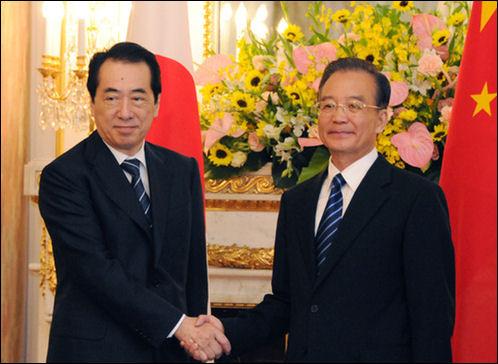
Japanese Prime Minister Naoto Kan with a less than cordial Wen Jiabao of China
Anti-Japanese Protest in China Over the Island Issue
Chinese nationalists staged anti-Japanese protest that in some cases became violent when Chinese security forces tried to break them up. One boisterous demonstrations with around 100 Chinese activists was staged outside the Japanese Embassy in Beijing. Some protesters there carried signs that read “Burn you Japan !” and shouted “Boycott Japanese products!” The were also protests outside Japanese consulates in Shanghai, Shenyang and Shenzhen.
Thousands took to the streets in Chengdu, unfurling banners and shouting slogans such “Defend the islands” and “Fight Japan.” Protestors there broke into the Japanese retailers Ito-Yokado and Isetan and broke windows. One witness told the Yomiuri Shimbun, “One after another, young people on the roadside joined the procession of university students, and the number of protestors quickly swelled...Police soon lost control.” In Tianjin an international school was attacked by angry Chinese. In Xian, thousands of college students marched while holding flags and banners, shouting slogans such as “Boycott Japanese goods.” Windows were broken and display cases were shattered at Mizuno and Sony retail stores.
In Zhengzhou, college students assembled in the downtown square and marched through the streets , shouting “Long live the motherland” and “Return the islands to China.” There were also anti-Japanese protests in Wuhan, Hebei Province and Deyang and Minyang, Sichuan Province, where more than 10,000 people gathered. In Deyang protesters referred to Japan using a derogatory term that roughly translated to “small Japan” and waved placards reading “Listen to the Voice of the Fatherland.” In Miyang protestors broke windows of Japanese cars and trashed a Japanese restaurant. [Source: Kyodo]
Japan Purchases the Senkaku-Diaoyu Islands
In early September 2012, the Japanese government announced that it was in the process of purchasing the disputed Senkaku-Diaoyu islands from a private Japanese owner. The Yomiuri Shimbun reported: “The government and the owner of three of the Senkaku Islands have agreed on the purchase of the islets for about 2.05 billion yen ($26 million), according to government sources. The Tokyo metropolitan government was initially considering buying the islands, but with the latest move by the central government, the islets will be put under state control. [Source: Yomiuri Shimbun, September 6, 2012]
Jane Perlez wrote in the New York Times, “The Chinese government accused Japan of stealing the disputed islands hours after the Japanese government announced that it had bought them from their private Japanese owners. In a show of strength, China sent two maritime law enforcement ships to the islands, which are known as the Diaoyu in China and the Senkaku in Japan. The ships, belonging to the China Marine Surveillance, are commonly deployed in the South China Sea, where China and its neighbors have other territorial disputes over islands. [Source: Jane Perlez, New York Times, September 11. 2012]
In April 2012 Tokyo governor Shintaro Ishihara said he planned to use public money to buy the Senkaku-Diaoyu Islands, a group of resource-rich islands known in China as the Diaoyu. They islands are are controlled by Japan, but claimed by China and Taiwan. also of islands at the centre of a dispute between Japan and China. The move was condemned by Chinese officials as illegal. Later Japanese Prime Minister Yoshihiko Noda said that the Japanese government would buy the islands. [Source: BBC, April 16, 2012]
“Ishihara, who is known for being outspoken, made the claim during a speech at the Heritage Foundation, a think-tank in Washington, the BBC reported. He said that he was in discussions with the private Japanese owner of three of the islands in the disputed chain. Chinese Foreign Ministry spokesman Liu Weimin said in a statement that China had "indisputable sovereignty" over the islands, and that any unilateral action from Japan would be "illegal and invalid".
On August 15, 2012, Hong Kong activists reach the disputed islands by sea for the first time since 1996, with seven activists disembarking onto the island. Reuters reported; “Fourteen activists from China, Hong Kong and Macau travelled by boat to the group of islands, called Senkaku in Japanese and Diaoyu in China, on the emotionally charged anniversary of Japan's surrender at the end of the second world war. Five were arrested on the islands, and nine others detained on their boat, Japan's coastguard said earlier.
Anti-Japanese Protests After Japan Purchases the Senkaku-Diaoyu Islands
Anti-Japan protests erupted in China over the Senkaku-Diaoyu dispute in August, September 2012 Keith Bradsher, Martin Fackler, and Andrew Jacobs wrote in the New York Times: “Anti-Japanese protests spread across China over the landing of Japanese activists on a disputed island and the treatment of activists from Hong Kong, Macau and China who had landed on the same island. Protesters took to the streets in nearly a dozen Chinese cities in up and down China’s eastern provinces, according to Xinhua, the official news agency. [Source: Keith Bradsher, Martin Fackler, and Andrew Jacobs, New York Times, August 19, 2012]
In early September 2012, A man attacked the car carrying the Japanese ambassador in Beijing on Monday and ripped off the Japanese flag flying on the vehicle, Japan's Kyodo news agency reported, amid escalating tensions that led to the biggest anti-Japan protests in years. Kyodo, quoting Japanese embassy officials in Beijing, gave no further details of the attack, but said the ambassador, Uichiro Niwa, was unhurt. The report said the embassy had "filed a strong protest with the Chinese Foreign Ministry". [Source: Reuters, September 6, 2012]
On September 15, 2012, the biggest anti-Japanese protests since China and Japan normalised diplomatic relations in 1972 were held in cities across China. The Japanese embassy in Beijing was besieged by thousands of protesters throwing rocks, eggs and bottles. The next day anti-Japanese protests broke out in dozens of mainland cities for a second day. In some cities peaceful protests turned violent as protesters clash with policemen, attack Japanese made cars and smash up Japanese restaurants. China’s state-run news media has made repeated calls for the islands to be given to China, which claims that it controlled them before Japan’s colonial expansion in the late 19th century.
The Japanese press reported that Japanese were assaulted in Shanghai Yasuharu Seki wrote in the Yomiuri Shimbun: The Japanese Consulate General in Shanghai has issued a warning regarding the spate of assaults on Japanese nationals by Chinese in the city--four of which have resulted in injury--since the government decided to nationalize the Senkaku-Diaoyu Islands.On its website, the consulate general called for Japanese residents and tourists in Shanghai to take precautions.[Source: Yasuharu Seki, Yomiuri Shimbun, September 15, 2012]
The website and other sources cited one instance in which a Japanese national walking in downtown Shanghai was kicked in the legs several times by a Chinese resident, causing bruises. The incident occurred after the Chinese asked if the person was Japanese. In another case, a group of Japanese dining at midnight were hassled by some Chinese and assaulted. Additionally, a Japanese national riding in a taxi was followed by a motorcyclist, who demanded the taxi driver force the Japanese passenger from the car, the consulate general said.
The consulate general also cited another instance when several Japanese walking on a sidewalk were harassed by Chinese residents who called them "Japanese," and one threw noodles at a Japanese, resulting in injuries. Another broke and stole a Japanese national's glasses.
Perry Link wrote in the New York Review of Books, Chinese protests have reached some peculiar extents. A Chinese clothing store called Pattad offers a 15 percent discount to anyone who enters and yells, “The Diaoyu Islands belong to China!” (You get 20 percent off if you yell “Japan belongs to China!”) A boy interviewed on the street says, “When I grow up I want to build tanks to annihilate Japan.” [Source: Perry Link, New York Review of Books, September 20, 2012]
Image Sources: University of Texas maps
Text Sources: New York Times, Washington Post, Los Angeles Times, Daily Yomiuri, Times of London, Japan National Tourist Organization (JNTO), National Geographic, The New Yorker, Time, Newsweek, Reuters, AP, Lonely Planet Guides, Compton’s Encyclopedia and various books and other publications.
Last updated December 2012
